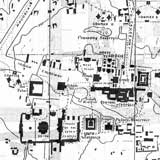Scientific Organization: Renée Koch-Piettre (EPHE, ANHIMA), Odile Journet-Diallo (EPHE, IMAF), Phoebe Giannisi (UTH)
Workshop Organization: Phoebe Giannisi, associate professor, Department of Architecture University of Thessaly
in collaboration with: Vasiliki-Maria Plavou, Chara Stergiou
Suppored by: Labex HASTEC (Laboratoire européen d’histoire et d’anthropologie des savoirs, des techniques et des croyances), UMR ANHIMA : Anthropologie et Histoire des Mondes antiques, IMAF : Institut des Mondes Africains), Department of Architecture, University of Thessaly (Volos, Greece).
Recent years have seen the development work on the "places of memory" in an essentially museum or conservatory perspective. The historians of religions, ethnologists, linguists, on the other hand, take into account the long time, even when the work focus, as seen today, transitions, passages, mutations rather than permanence. They have to deal with the accumulation, strata and inheritance. This aspect is particularly clear when we examine the intimate relation between a territory and a human organization which discovers into territory supernatural entities and deciphers it into its elementary signs before it print it with its own inscriptions and receive from it reading of signs of its own destiny. The surface of the earth, as a palimpsest, keeps track underneath the new writing of territory, of its older versions. A symbolic elaboration of the territory, alive, cumulative and continuous, not without crises and changes of rhythm, seems also crucial in shaping the individual than in structuring the society. The size, irreversibility and potential entropic of the changes that economic and political developments of the last two centuries have brought into the human cultures appear clearly if we manage to uncover the repressed versions of links that societies have into the time and space weaved with the places where they dwell, — these early "texts" (in the etymological sense of the word) that we find filed, deeply buried in the memory, often forgotten, in the trips, the gestures and body as well as in the language and representations.

